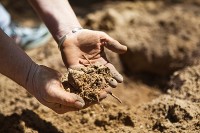Harmonized World Soil Database (HWSD v 1.21)
This state-of-the-art database was established in July 2008 by IIASA and FAO in partnership with:
- ISRIC-World Soil Information which, together with the FAO, contributed recent regional soil and terrain databases together with the WISE soil profile database;
- The European Soil Bureau Network, which provided its major new update of soil information for Europe and northern Eurasia; and
- The Institute of Soil Science, Chinese Academy of Sciences, which made available its most recent 1:1,000,000 scale Soil Map of China.
The data entry and harmonization within a GIS was carried out at IIASA; verification of the database was undertaken by all partners.
HWSD was last updated in 2013.
FAST FACTS
The HWSD constitutes significant improvements for about 60% of the land area in comparison with the FAO/UNESCO Soil Map of the World.
Further expansion and update of the HWSD is foreseen to include the soil information available in the USA, Canada, Australia, India, Pakistan, and a number of West African countries.
The HWSD is already being widely used as academic resource in universities and as background information in international organizations like the EU, the UN and World Bank to improve technical support measures to developing countries.
About HWSD
HWSD has two main goals:
- To increase the quantity and quality of data available by capturing data at a grid cell size of 30 arc seconds of longitude and latitude (approximately, l km);
- To harmonize and expand soil attribute information (texture, composition) with recently collected soil data.
An additional incentive for producing HWSD was the need to enhance the edaphic assessment procedures for agricultural crops within the context of the FAO/IIASA Global Agro-ecological Zones assessments.
Until the release of HWSD, the standard global soil map was the 1:5,000,000 scale FAO–UNESCO Digital Soil Map of the World, compiled in the 1970s. As large volumes of new data had recently been assembled by national and regional soil institutions, FAO and IIASA decided to combine these with the information contained in the FAO-UNESCO Digital Soil Map of the World to produce the new comprehensive soil database, HWSD.
How HWSD works
The HWSD is composed of a raster image file and a linked attribute database. The raster database consists of 21600 rows and 43200 columns, of which 221 million grid cells cover the globe's land territory.
Each grid cell in the database is linked to commonly used soil parameters, namely, organic carbon, pH, water storage capacity, soil depth, cation exchange capacity of the soil and the clay fraction, total exchangeable nutrients, lime and gypsum contents, sodium exchange percentage, salinity, textural class, and granulometry. HWSD allows soil compositions to be displayed or queried in terms of user-selected soil parameters.
The HWSD Viewer allows soil association compositions to be displayed or queried in terms of user-selected soil parameters, and it provides a geographical tool to query and visualize the database. For modeling, the HWSD and its geographical layer can directly be read or imported by common GIS and Remote Sensing software.
The HWSD allows the soil components and attributes to be seen at a high level of spatial resolution at the global scale.
Background
Soil information, from the global to the local scale, has often been the one missing biophysical information layer. Its absence has added to the uncertainties of predicting potentials and constraints for food and fiber production. The lack of reliable and harmonized soil data has considerably hampered global assessments and environmental impact studies, land degradation assessments and adapted sustainable land management interventions.
Challenges
Many of today's urgent challenges will benefit from HWSD, including current and future estimations of potential land productivity, identification of land and water limitations, and improved assessment of the risks of land degradation, particularly soil erosion.
HWSD provides national and international agricultural planners with a tool for resolving questions about land suitability for crop cultivation and bioenergy feedstocks, such as corn, sugar cane, and grasses. This is important for rational natural resource management, making progress towards eradicating hunger and poverty, and addressing food security and sustainable agricultural development, especially with regard to the threats of global climate change impacts and its urgent needs for adaptation and mitigation.

DOWNLOAD HWSD


